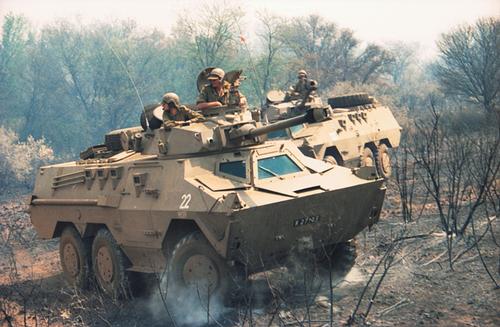|
|
| Customs of the South African Armoured Corps | |

|
|
Stables Go top
The Tradition of STABLES
Towards the latter part of the 19th Century, perhaps in the late 1870's, when the antecedent units of the Natal Mounted Rifles were made up of troops of cavalry raised from the farming area and called to serve their regiment for a specific campaign, a trooper usually received in his call up instruction to report with his own horse, saddle, rifle and rations.
His horse was to be his only mode of transport to, during and from the battle, no matter how difficult the conditions. As a consequence the association the trooper formed with his horse was especially close and respectful. Without proper care, the trooper could find himself in an untenable situation.
To the tradition came about when the trooper was cheerful in the warmth of the mess tent and the cold swirled the manes and tails of the horses tethered to the piquet lines outside, it was fit and proper to spare a thought for their sturdy ponies which had brought them there.
Thus at an appropriate moment during the meal the mess president called upon the table to rise and remember the horses, at this call all rose. The PMC would say GENTLEMEN STABLES to which all would reply THE HORSES.
Two variations exist.
The first has the assembled company stand for a moments silence to the horses suffering outside whilst they enjoyed warm food inside.
The second is where the mess president proposes a toast to the horses. Simultaneously he calls upon the assembly to rise and remember the horses. All rise. The PMC raises his glass and proposes the toast LADIES AND GENTLEMEN STABLES. All reply THE HORSES Glasses are emptied to complete the toast.
The second toast is the most common.
If the toast to the horses is called during an Armour Shot Action, it is followed by the singing of OU RYPERD
|
| |
Spurs Go top
The Tradition of SPURS
The Spur has been an integral part of the history of cavalry in warfare dating back to very early times. Cavalry was used in warfare by the Carthaginians, Persians and after a humiliating defeat of the Legions in AD301, by the Romans. The first great age of Cavalry in warfare, however was in medieval times when cavalry was used as a mass formation to crush Infantry creating the same psychological effect as a modern tank formation in attack. The knights, with heavy armour and mobility were invincible against the infantry who had little protection and no support (Artillery).
Spurs were an integral part of the knight's equipment. To WIN ONEs SPURS was a reference to the individual gaining his knighthood.
The end of cavalry in modern warfare was witnessed during the Anglo-Boer war 1899-1902. The last cavalry charge in modern times took place at Elandslaagte on October 21 1899. The spur became a vestige of an age when the horse was the instrument of mobility on the Battlefield.
Many of South Africa's Traditional Regiments were used as mounted infantry and subsequently, as armoured troops in tanks and armoured cars. In keeping with the proud cavalry heritage of the mounted troops, the spur is still worn with ceremonial dress.
The ceremony of the spur serves to perpetuate this heritage by enabling those members of Armour Regiments affiliated to Traditional Cavalry Regiments to wear this important symbol of their cavalry past.
|
| |
Diesel and Dust Go top
The world of the Armour soldier is known as a MAN's WORLD because of the diesel smell and the dust, which is part and parcel of the hard and difficult training with tanks and armoured cars.
On special occasions members of the SAAC drink a special brew from a set consisting of a copper oil can and chalices made from 12.7 mm cartridge cases. A toast is proposed on the Flame of the Armour to symbolically strengthen the spirit and Esprit de Corps of the unit members.
Diesel and Dust is normally enjoyed at the following occasions:
- Just before the start of the Training Commencement Ceremony
- Before the Unit Colours are uncased or taken on parade.
- On the Unit birthday, just before the morning conference by the senior staff members, the unit commander and RSM
- After an exceptional achievement by the unit.
- At the Shot Action for the toast on the Flame of the Armour
- At Armour Traditional Dinners
The Unit second in command, adjutant and RSM are responsible to ensure that this custom is used in orderly fashion at suitable occasions.
The recipe for Diesel and Dust is as follows:
- 1 x 750ml Oude Meester Brandy / Witblits or Mampoer.
- 250ml coffee extract (boil 250ml water with 5 heaped teaspoons of coffee powder and 125ml sugar)
- Mix all the ingredients as soon as the coffee extract has cooled.
- Pour into a suitable bottle and let it stand for about two weeks before using.
|
| |
Combined tea Go top
A Unit should conduct a COMBINED TEA for all unit members at least once a month.
The unit commander will use this opportunity to present any certificates and to congratulate staff members on their birthdays. Also to notify staff members of any engagements, weddings, childbirths, sports achievements, etc
The Unit Chaplin will read from the Bible and say a prayer
|
| |
Morning coffee Go top
It is customary that all officers, warrant officers and non- commissioned officers will enjoy a cup of coffee JAVA in the mornings before work in their respective tearooms.
Between 07:30 and 07:45 all these must be in their tearooms.
JAVA is an international armour name given to coffee and refers to the origin of the brew. From research it has been determined that this name has been in use since the Second World War for strong black coffee.
|
| |
|
|
|
|